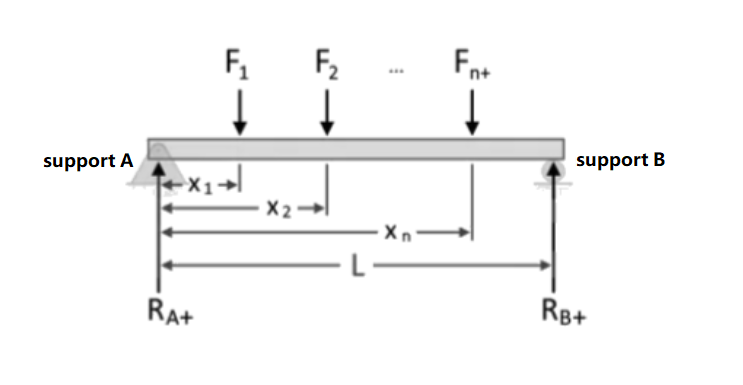1. What is the Beam Load Calculator?
Definition: This calculator determines the vertical reaction forces at the supports (A and B) of a simply-supported beam subjected to multiple point loads.
Purpose: It assists engineers and designers in analyzing the external forces acting on a beam, which is essential for structural design and ensuring stability.
2. How Does the Calculator Work?
The calculator uses equilibrium equations for a simply-supported beam:
- Sum of vertical forces: \( \sum F_y = 0 \implies R_A + R_B - \sum P_i = 0 \)
- Sum of moments about A: \( \sum M_A = 0 \implies \sum P_i d_i - R_B L = 0 \)
Solving these gives:
- \( R_B = \frac{\sum P_i d_i}{L} \)
- \( R_A = \sum P_i - R_B \)
Where:
- \( R_A \): Reaction force at support A (N or lbf);
- \( R_B \): Reaction force at support B (N or lbf);
- \( P_i \): Point load magnitudes (N or lbf, positive downward, negative upward);
- \( d_i \): Distances from support A (mm, cm, m, in, or ft);
- \( L \): Beam span (mm, cm, m, in, or ft).
Steps:
- Enter the beam span and its unit (mm, cm, m, in, or ft).
- Specify the number of point loads (0 to 10).
- For each load, enter the magnitude (N or lbf) and distance from support A (same units as span).
- Convert all inputs to SI units (N, m).
- Calculate \( R_B \) using the moment equilibrium equation.
- Calculate \( R_A \) using the force equilibrium equation.
- Convert reactions to the selected output unit (N or lbf).
- Display results, formatted in scientific notation if the absolute value is less than 0.001, otherwise with 4 decimal places.
3. Importance of Beam Load Calculation
Calculating support reactions is essential for:
Structural Analysis: Provides the forces needed to analyze internal stresses and deflections.
Design Safety: Ensures supports can withstand applied loads without failure.
Foundation Design: Informs the design of foundations or anchorage systems.
Code Compliance: Verifies that the structure meets engineering standards.
4. Using the Calculator
Example 1 (Metric Units): Calculate reactions for a simply-supported beam with two point loads:
- Beam Span: \( L = 4 \, \text{m} \);
- Loads: \( P_1 = 10 \, \text{kN} = 10000 \, \text{N} \) at \( d_1 = 2 \, \text{m} \), \( P_2 = 3.5 \, \text{kN} = 3500 \, \text{N} \) at \( d_2 = 2.5 \, \text{m} \);
- Output Unit: Newtons;
- Moment Sum: \( \sum P_i d_i = 10000 \times 2 + 3500 \times 2.5 = 20000 + 8750 = 28750 \, \text{N·m} \);
- Reaction B: \( R_B = \frac{28750}{4} = 7187.5 \, \text{N} \);
- Reaction A: \( R_A = (10000 + 3500) - 7187.5 = 6312.5 \, \text{N} \);
- Result: \( R_A = 6312.5000 \, \text{N}, R_B = 7187.5000 \, \text{N} \).
Example 2 (Imperial Units): Calculate reactions with one point load:
- Beam Span: \( L = 10 \, \text{ft} \);
- Load: \( P_1 = 2000 \, \text{lbf} \) at \( d_1 = 4 \, \text{ft} \);
- Output Unit: Pounds-force;
- Convert to SI: \( L = 10 \times 0.3048 = 3.048 \, \text{m} \), \( P_1 = 2000 \times 4.44822 = 8896.44 \, \text{N} \), \( d_1 = 4 \times 0.3048 = 1.2192 \, \text{m} \);
- Moment Sum: \( \sum P_i d_i = 8896.44 \times 1.2192 \approx 10846.88 \, \text{N·m} \);
- Reaction B: \( R_B = \frac{10846.88}{3.048} \approx 3559.02 \, \text{N} \approx 800 \, \text{lbf} \);
- Reaction A: \( R_A = 8896.44 - 3559.02 \approx 5337.42 \, \text{N} \approx 1200 \, \text{lbf} \);
- Result: \( R_A = 1200.0000 \, \text{lbf}, R_B = 800.0000 \, \text{lbf} \).
5. Frequently Asked Questions (FAQ)
Q: Can I include the beam’s weight?
A: Yes, enter the beam’s weight as a point load at the center (e.g., half the span length). The calculator assumes a weightless beam unless specified.
Q: What if I have distributed loads?
A: Convert distributed loads to equivalent point loads at their centroids. For example, a uniform load \( w \) over length \( L \) is equivalent to a point load \( w L \) at \( L/2 \).
Q: Why are reactions zero when no loads are applied?
A: With no external loads, the beam is in equilibrium with zero reaction forces, assuming it’s weightless.
 Home
Home
 Back
Back
